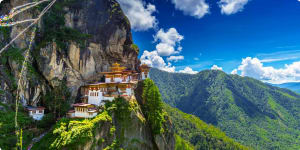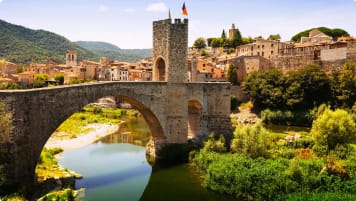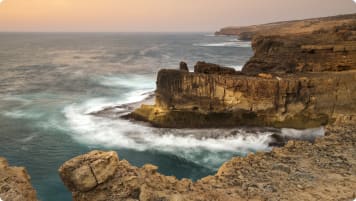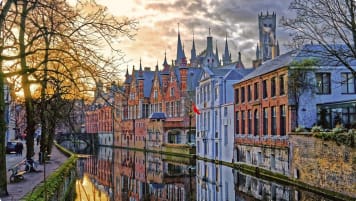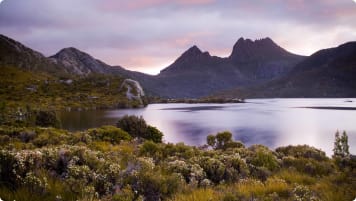Tour of Darjeeling, Sikkim, and Bhutan
Join Odyssey Traveller on this small group tour in the Indian subcontinent, taking us from the verdant tea gardens of Darjeeling nestled in the Himalayan mountain range, to the hilltop monasteries of the former independent kingdom of Sikkim, and finally to the pristine and beautifully isolated mountain landscape of Bhutan.
From A$12,925AUD

Highlights
- 1. Take a toy train ride on the Darjeeling Himalayan Railway, a UNESCO World Heritage Site which has the highest railway station in India.
- 2. Travel through the lush green tea gardens and forests of Dooars in northeastern India.
- 3. Explore several monuments related to Tibetan Buddhism in Sikkim.
- 4. Walk up to the Taktsang Monastery (Tiger’s Nest Monastery), an iconic Bhutanese cultural landmark nestled in the Paro Valley.

Departure Dates
| Departure Date | Price |
|---|---|
| 03 November 2025 Ends 16 November 2025 • 14 days A$13,125 Twin A$14,925 Single Available | Selected |
| 06 April 2026 Ends 19 April 2026 • 14 days A$13,550 Twin A$15,150 Single Available | |
| 02 November 2026 Ends 15 November 2026 • 14 days A$13,550 Twin A$15,150 Single Available | |
| 12 April 2027 Ends 25 April 2027 • days A$13,850 Twin A$15,150 Single Available | |
| 08 November 2027 Ends 22 November 2027 • days A$13,850 Twin A$15,150 Single Available |
Tour of Darjeeling, Sikkim, and Bhutan
Join Odyssey Traveller on this small group tour in the Indian subcontinent, an incredible journey taking us from the verdant tea gardens of Darjeeling nestled in the Himalayan mountain range, to the hilltop monasteries of the former independent kingdom of Sikkim, and finally to the pristine and beautifully isolated mountain landscape of Bhutan.
This 14-day tour of Darjeeling and Sikkim in India and the country of Bhutan will show you the interaction of old and new cultures, and how the people preserve years-old traditions and untouched landscapes while embracing modernity. This is a region of immense historical and cultural importance. We will visit a number of important destinations that will give us insight about the effects of the British Empire and the history of the Kingdom of Sikkim that flourished in the Indian subcontinent prior to colonisation. We will also have a chance to enter the isolated enclave of Bhutan to learn about its festivals and cultural practices. This is a small group tour for a group of up to 16 mature and senior travellers joining with their partner or as a solo traveller that will enrich the senses with its magical scenery, but will also enrich the mind by teaching us about the unique places to which the rest of the world have had no or limited prior access. This group tour requires a reasonable level of fitness.
India has 38 UNESCO World Heritage Sites, one of which we will see on this tour. The Darjeeling Himalayan Railway is one of the three railways listed as the UNESCO World Heritage Site "Mountain Railways of India". Opened in 1881, UNESCO describes it as "the first, and is still the most outstanding, example of a hill passenger railway." Bhutan has eight sites on the UNESCO Tentative List, and we will visit the Taktsang Monastery (Tiger’s Nest Monastery), an iconic cultural landmark located in the Paro Valley. This monastery is associated with Guru Padmasambhava, also known as Guru Rinpoche or "second Buddha", who is believed to have introduced Buddhism into the Indian subcontinent in the 8th century. We will also explore the sights and the beautiful dzong architecture of the capital of Bhutan, Thimpu.
This small group tour is perfect for the active mature-aged and senior travellers who are after a diversity of scenery and experiences, but also want convenience and comfort. Nearly all of the daily meals are provided on this tour, especially during the Bhutan leg of the trip, giving you a chance to try each destination's unique cuisine.
Odyssey Traveller has been serving global travellers since 1983. As always, couples and solo travellers are welcome, and similar to other Odyssey Traveller tours, you will be accompanied at all times by a Program Leader and local guides who will share their knowledge of the places visited.
History of Darjeeling, Sikkim, and Bhutan
The histories of Darjeeling, Sikkim, and Bhutan are intertwined. Darjeeling, noted for its tea industry, is located within the state of West Bengal in northeastern India. Until the early 19th century, Darjeeling was ruled by the Kingdom of Sikkim. The kingdom, situated between modern-day Nepal and Bhutan, was established in 1642 and fought a series of territorial wars with its two neighbours.
In the war between British troops and Nepal that broke out in 1814, Sikkim sided with the British; the kingdom later became a de facto protectorate of the British Empire. The British East India Company, which had taken over most of the Indian subcontinent, took over the formerly Sikkim-ruled Darjeeling in 1835, and built a sanatorium and extensive tea plantations in the region.
Though Bhutan was never colonised, it was forced to cede control of its foreign relations to the British in 1910, a role that was inherited by India in 1949 following that country’s independence from British rule. Sikkim became a protectorate of India in 1950 and later joined the country as its 22nd state. Bhutan began to develop its own foreign relations, joining the United Nations in 1971. In 2008, Bhutan transitioned from an absolute monarchy to a constitutional monarchy.
Tour Itinerary Highlights
Darjeeling
We will travel to India, to Delhi for our first night, and fly from Delhi to Darjeeling.
Darjeeling lies 490 kilometres north of Calcutta at an elevation of about 2,100 metres above sea level, on the narrow mountain ridge of the Sikkim Himalayas. Here we will experience an early morning drive to Tiger Hill (2,573 metres) in order to see the dawn light breaking over the snow peaks of the Himalayan mountain range.
Darjeeling is a town located in the foothills of the Himalayas, so this promises to be a scenic drive along a country road dotted with tea gardens, agricultural fields, and small villages. Visible from Tiger Hill are Mt Everest and Mt Kanchenjunga (world's third highest peak), an unforgettable sight.
We will also take a narrow gauge train ride on the Darjeeling Himalayan Railway, a UNESCO World Heritage Site which has the highest railway station in India sitting at 2,258 metres.
Sikkim
In Sikkim, we will explore the capital of Gangtok. Gangtok is the capital of the mountainous Indian state of Sikkim, a former Himalayan Kingdom.
We will see several monuments related to Tibetan Buddhism, such as the Rumtek Dharma Chakra Centre (Rumtek Monastery). Originally built in the 18th century, it was rebuilt in 1960 by the 16th Gyalwa Karmapa (Rangjung Rigpe Dorje, 1924–1981) after he fled Tibet. The Gyalwa Karmapa is the spiritual leader of the Karma Kagyu, one of the major schools of Tibetan Buddhism. It is a replica of the Kagyurpa Monastery in Tsurphu, Tibet.
We will travel through the lush green tea gardens and forests and visit Gorumara, a popular wilderness retreat and a national park. This a true wildlife sanctuary, a reserve forest since the 1890s and untouched by human habitation.
Bhutan
From Sikkim, we drive to the border of Bhutan. Here we will be met by our Bhutanese guide and driver.
A highlight of any visit to Bhutan typically includes watching and participating in one of the many festivals held throughout the year and the temples of Bhutan.
The most famous is the iconic Taktsang Monastery (Tiger’s Nest Monastery) in the Paro Valley. This involves a hike of 3-4 hours to reach the site, on a 900-metre ascent up to the monastery at 3,120 meters. This monastery is associated with Guru Rinpoche, who is venerated as a "second Buddha" by adherents of Tibetan Buddhism in Tibet, Nepal, Bhutan, and the Himalayan states of India. Even if you decide not to reach the monastery itself, there is a tea shop around the halfway mark, which provides excellent views of the monastery.
Another highlight is the National Textile Museum. The Bhutan Textile Museum was opened in 2001 at the instruction of Queen Ashi Sangay Choden, one of the four wives of the old Bhutanese King Jigme Singye Wangchuck. The national museum was established to preserve and showcase the rich cultural heritage that has been preserved between Bhutan’s mountainous ridges. The building itself was constructed to replicate a traditional Bhutanese house. Visitors really get a full taste of the country’s cultural heritage, and the lingering influence of tradition on the present.
These are only a few of the places we will visit in Darjeeling, Sikkim, and Bhutan. For more details and to read about all of our destinations on this wonderful tour, click the ‘Top 5’ or ‘Itinerary’ buttons above! If you’re keen to experience this tour, please call or send an email. Or, to book, simply fill in the form on the right hand side of this page.
Articles about India published by Odyssey Traveller
- India’s Mughal Empire
- Clash of the Mughals and the Marathas
- History of British Rule in India
- Discovering India
- Top 20 World Heritage Sites You Must Visit
For all the articles Odyssey Traveller has published for mature aged and senior travellers, click through on this link.
External articles to assist you on your visit to India
- 7 Wonders of India (World Atlas)
- New Seven Wonders of the World (Travel Channel)
- 7 Things You Didn’t Know About the Qutub Minar (National Geographic Traveller India)
- Incredible India
Articles about Bhutan published by Odyssey Traveller
For all the articles Odyssey Traveller has published for mature aged and senior travellers, click through on this link.
External articles to assist you on your visit to Bhutan
Gallery
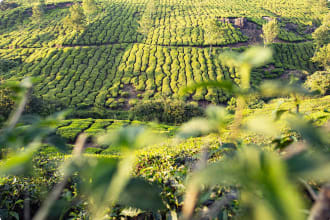
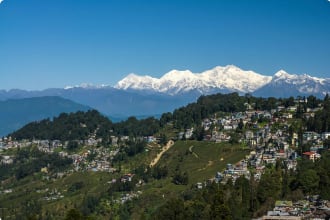
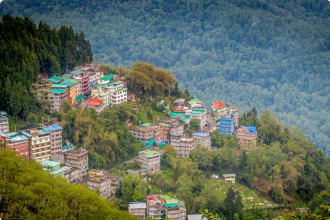
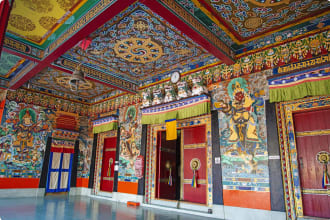
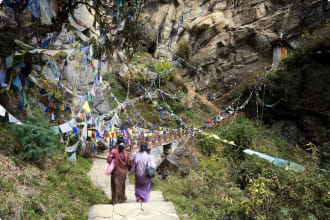
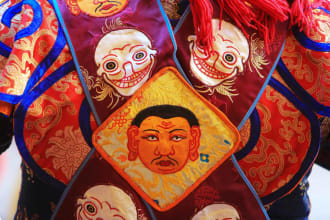
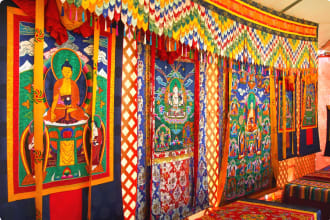
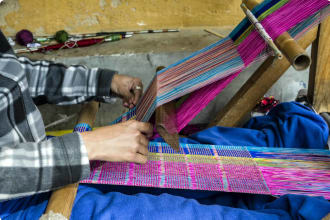

Itinerary
14 days
Day 1: Delhi, India
Accommodation: Pride Plaza Aerocity or similar
Upon arrival in Delhi make your own way to our hotel. In the evening, we meet as a group for an introductory briefing and our welcome dinner.
(D)
Day 2: Darjeeling
Accommodation: The Elgin or similar
In the early morning, we transfer to Delhi airport for your 2 hour flight to Bagdogra Airport; a small, but busy airport for North Bengal and Sikkim surrounded by lush green tea gardens on the Himalayan foothills. On a clear day you will be able to see the long mountain range of the Himalayas from the flight. From Bagdogra, we will be driven to Darjeeling (3 hours). The journey runs on the traditional Hill Cart Road snaking its way through the Sal forests of Mahananda Wildlife Sanctuary and then slowly climbing up the hills to Kurseong – a tea growing area dotted with lush green garden. The narrow-gauge Himalayan rail track follows you as you cross several small picturesque villages on your way. You will also have the opportunity to see the toy train running on heritage steam engine. The view of the snow-clad mountains in the horizon gets prominent as you climb up the hills towards Darjeeling. On arrival we check in to our hotel.
In the evening you can go for a short walk to the Mall or Chowrasta to get a feel the daily buzz of local life. This is an important social gathering place in Darjeeling where the tourists as well as the local people come, meet, shop and dine. Dinner will be in the hotel tonight.
(B, D)
Day 3: Darjeeling - Ghoom - Darjeeling
Accommodation: The Elgin or similar
We will take an early morning drive to Tiger Hill (2,573 metres) in order to see the dawn light breaking over the snow peaks before sunlight even reaches the lowlands. Visible from Tiger Hill are Mt Everest and Mt Kanchenjunga (world’s third highest peak), an unforgettable sight. The summit at Tiger Hill also commands a fine view of the vast plains of North Bengal.
Tiger Hill is also the summit of Ghoom (also spelled Ghum), a small locality that is home to the highest railway station in India, the Darjeeling Himalayan Railway (or Toy Train) sitting at 2,258 metres. We will take a toy train ride to Ghoom. The steam locomotive snakes its way through the zigzag trails and loops. It makes a round at the picturesque Batasia Loop with Kanchenjunga as the constant backdrop. At Ghoom, we will visit the Himalayan Railway Museum before returning to Darjeeling.
In the afternoon we will explore Darjeeling by foot, which is the best way to explore the city. Walk with our guide through the lanes and by-lanes and see the uncommon faces of Darjeeling as closely as possible. During the walk, we show you the most important landmarks in the town and also take you to the local markets where the real life of Darjeeling flows unaffected by the influence of tourism. Your walking experience gets more delightful with the charming landscape scenery around you, which is dominated by lush tea gardens and Mt Kanchenjunga. There are centuries-old buildings and houses in Darjeeling that still reflect traditional British architecture. Added to this, the churches, monasteries, monuments, the people & culture, unique flora & fauna, majestic mountains & valleys, toy train, tea garden, old shopping places and food joints, and many other great old & modern attractions constitute the rich heritage of Darjeeling.
We will visit The Himalayan Mountaineering Institute, which boasts a rich and rare collection of exhibits.
We will also visit the Himalayan Zoo – a high altitude wildlife park and new home for Siberian Tiger, Himalayan Black Bear, Red Panda, Snow Leopard and many endemic Himalayan species.
Back to the city and you can visit the local market of fashionable handicrafts and jewellery. Laze away in the Mall – the hub of the town or, have a cup of coffee at Caventer’s open air restaurant and watch a glorious sunset.
Dinner is at your hotel tonight.
(B, D)
Day 4: Darjeeling - Gangtok
Accommodation: Norkhil Hotel or similar
Today we drive to Gangtok via Peshok road (4 hours). The view of the fascinating tea gardens at Peshok with the Kanchenjunga snow range and Rangit River Valley will demand you to stop for a while for a refreshing break.
From the road junction of Tista Bazar, we follow the winding road along the emerald River Tista. To break up the drive, we can spend time in some scenic spots on the way to enjoy the landscape.
Before reaching Gangtok we will make a detour to Rumtek Monastery, also known as the Dharma Chakra Center, which is the most important and largest monastery pilgrim centre in Sikkim. It was built in 1960 to spread the teachings of Buddha, by the 16th Karmapa Gyalwa, who came from Tibet to Sikkim during the Chinese invasion. The Rumtek Monastery belongs to the Black Hat sect of Kargyugpa Buddhism which has its origin in Tibet in the 12th century.
Optional local lunch at a farm house can be arranged at an additional cost.
We continue to Gangtok which you will reach by late afternoon. The capital town of Sikkim – a former Himalayan Kingdom – welcomes you with its typical traditional hospitality. This is a buzzing town with fusion of modern and traditional culture. Established as a Buddhist pilgrimage site in the 1840s, the city became capital of an independent monarchy after British rule ended, but joined India in 1975.
If you are not tired after checking in to your hotel, you can go for a short visit to the market or walk on the M G Marg – the most popular area in Gangtok town to shop, gossip and dine.
Dinner will be at your hotel tonight.
(B, D)
Day 5: Gangtok - Rumtek - Gangtok
Accommodation: Norkhil Hotel or similar
Today we will explore Gangtok. We will first visit the Enchey Monastery. This important monastery, built by the 8th Choygal of Sikkim in 1840, follows the Nyingma order of Tibetan Buddhism. Located at an isolated place on top of a hill over the Gangtok town the construction of the monastery resembles the Chinese archaeology and looks like a pagoda. The monastery also provides a nice view of the mountains on a clear day.
We will aslo visit Honuman Tok, or the temple of the Lord Hanuman (The Langur) with a nice viewpoint is situated on the way to Nathula Pass about 5kms from the Gangtok city centre. At an altitude of 2200 M, the viewpoint presents a nice view of the surrounding including the Kanchenjunga.
Last on our tour, we will visit the Flower Show and Exhibition centre; if you have the interest to see the exotic Himalayan flowers and orchids, the Orchid Center in Gangtok is a must. The Flower and Orchid exhibition centre has a huge collection of rare Himalayan orchids and flower.
Later you may want to take a stroll around the market area. Unlike the MG Marg Market, Lal Bazaar is more popular with city people and not tourists. But those who want to experience the regular daily life of the local people of Gangtok may find this place quite interesting. You may also choose to take an evening walk along the quiet ridge park road and enjoy the beauty of the hills.
(B, D)
Day 6: Gorumara National Park
Accommodation: Baradighi Bungalow or similar
Today after breakfast we set out for a journey to Gorumara National Park in the foothills of the Himalayas (5 hours). The first phase of our journey runs through the hills dotted with beautiful forests and villages. From here the road goes down to the vast plains of Dooars, lying in the outer foothills of the Himalayas. We travel through the lush green tea gardens and forests–the unique features of Dooars.
We continue to Gorumara – a popular wilderness retreat in the Dooars plains and a national park. This a true wildlife sanctuary, a reserve forest since the 1890s and untouched by human habitation.
The afternoon is free to relax in the beautiful garden of your hotel, alternatively, for those who wish, you can sign up for an exclusive car safari to Gorumara National Park, through the deep natural grasslands of Gorumara, and if you’re lucky you may spot a rhinoceros or a bison!
Here we will also have the opportunity to see the different rural life of the plains of Bengal. In the evening, we will arrange a cultural show.
(B, D)
Day 7: Gorumbara - Thimpu, Bhutan
Accommodation: Namgay Heritage Hotel or similar
In the morning, we drive about 2.5 hours to the Bhutan border. Here we will be met by our Bhutanese guide and driver.
After lunch, we drive from the border town of Phuentsholing to Thimphu (5 hours), moving from the warmer climate of the south up to the foothills of the Himalayas. Thimphu is the capital and largest city of Bhutan.
On the way, visit Sangye Migyur Ling Lhakhang also known as the Tower of Milarepa.
If there is time, we can take an evening stroll around town and soak in the atmosphere of this magical capital with its busy shops and bazaars and photogenic citizens in national dress.
(B, L, D)
Day 8: Thimphu
Accommodation: Namgay Heritage Hotel or similar
Today we will enjoy a full-day sightseeing tour of the capital.
Among the places we will visit is the National Textile Museum. The Bhutan Textile Museum was opened in 2001 at the instruction of Queen Ashi Sangay Choden, one of the four wives of the old Bhutanese King Jigme Singye Wangchuck. The national museum was established to preserve and showcase the rich cultural heritage that has been preserved between Bhutan’s mountainous ridges. The building itself was constructed to replicate a traditional Bhutanese house. Visitors really get a full taste of the country’s cultural heritage, and the lingering influence of tradition on the present.
We also visit the Thimphu Chorten, the Golden Buddha (Buddha Dordenma). We explore the postal museum, showcasing Bhutan’s interesting stamps, as well as the Changangkha temple.
(B, L, D)
Day 9: Thimphu - Punakha
Accommodation: Khuru Resort or similar
In the morning drive approximately 3 hours to the old capital, Punakha, via Dochu La pass at 3050 metres, where we will stop for a hot drink and enjoy spectacular panoramic views of the Eastern Himalaya ranges. You will notice the change of climate and vegetation as we approach low-lying Punakha at 1250 metres.
For those who wish, we can take a pleasant walk for an hour or so across the terraced fields of Sopsokha village to Chimi Lhakhang (Temple of Fertility) built in the 15th century by the ‘Divine Madman’ (Lama Drukpa Kuenley).
We will visit also the imposing Punakha Dzong, “Palace of Great Happiness”. Built in 1637, it is strategically placed at the confluence of two rivers, the Po Chu and the Mo Chu.
(B, L, D)
Day 10: Punakha - Paro
Accommodation: Olathang Resort or similar
Early morning, hike an hour or so up to Khamsum Yuelley Namgyel Chorten, high on the hill across the other side of the valley. The temple is 30 metres tall and is dedicated to the fifth King. From the top you will see a beautiful view of the valley and surrounding villages.
We will enjoy a picnic lunch on the river bank today.
In the afternoon, we will return to Paro, a drive of approximately 4 hours.
(B, L, D)
Day 11: Paro
Accommodation: Olathang Resort or similar
We rise early to visit the spectacularly situated Taktsang Monastery (Tiger’s Nest Monastery), a highlight of any visit to Bhutan. This involves a hike of 3-4 hours to reach the site, on a 900-metre ascent up to the monastery at 3,120 meters. This monastery is associated with Guru Padmasambhava, also known as Guru Rinpoche, who is believed to have introduced Buddhism into the Indian subcontinent in the 8th century. He is venerated as a “second Buddha” by adherents of Tibetan Buddhism in Tibet, Nepal, Bhutan, and the Himalayan states of India.
There is a tea shop around the halfway mark, which provides excellent views of the monastery, and some visitors are content with reaching this site. We return in time for lunch, and the rest of the afternoon is free.
(B, L, D)
Day 12: Paro
Accommodation: Olathang Resort or similar
This morning we enjoy some more sightseeing together in Paro, visiting the Paro Rinpung Dzong, a large monastery and fortress and one of the finest examples of Bhutanese architecture. It houses the district Monastic Body and government administrative offices of Paro Dzongkhag.
We also visit the National Museum housed in the Ta Dzong (watch tower) which was built on top of the hill above Rinpung Dzong to defend Rinpung Dzong and the Paro valley during times of war, in an unusual circular construction resembling a conch shell. The Ta Dzong was badly damaged by an earthquake in September 2011, but has now been renovated. Here we see a magnificent collection of Bhutanese artefacts – costumes, religious paintings, arms, textiles and a fascinating collection of Bhutan stamps.
Near the museum we may also be able to see a demonstration of traditional wood turning skills by local artisans who make traditional wooden bowls and cups – and members of the group may try their hand in wood turning as well!
In the afternoon we will see the Drukgyel Dzong (fortress of victory), constructed to commemorate the victory over Tibetan invaders in 1644, and destroyed by a butter lamp fire in 1951. Nearby is the 7th century Kyichu Lhakhang, a temple of historical significance and one of the most sacred shrines in Bhutan.
(B, L, D)
Day 13: Paro - Delhi
Accommodation: Pride Plaza Aerocity or similar
Early in the morning your guide will accompany you to the airport to see you off onto your flight to Delhi and wish you Tashi Delek (goodbye and good luck).
You will be transferred to your hotel from the airport.
In the evening we meet again for a farewell dinner.
(B, D)
Day 14: Delhi
The tour concludes after breakfast.
(B)
Includes / Excludes
What’s included in our Tour
- Two domestic airfares in economy class
- 13 nights of hotel accommodation.
- 13 breakfasts, 6 lunches, and 13 dinners.
- Services of an Odyssey Tour Leader.
- Local guide throughout the tour.
- All sightseeing and entrance fees.
- Tipping and gratuities.
- Detailed preparatory booklet.
What’s not included in our Tour
- International flights.
- Comprehensive travel insurance.
- Meals not specified in the itinerary.
- Items of a personal nature such as drinks, alcohol and laundry.
Participants must be able to carry their own luggage, climb and descend stairs, be in good health, mobile and able to participate in 3-5 hours of physical activity per day, the equivalent of walking / hiking up to 8 kilometers per day on uneven ground.
Book now
Make it a private tour
Easing your journey
Crossing international borders with restrictions
The list of requirements to travel internationally has changed and will continue to change for several years. Odyssey is here to assist you in managing your way through these requirements:
For more information see our Crossing international borders with restrictions page.
Book With Confidence
If less than 30 days before your tour starts you are unable to travel as a result of Government travel restrictions, Odyssey Traveller will assist you with a date change, provide you with a credit or process a refund for your booking less any non-recoverable costs.
See Terms and conditions for details.
Peace of Mind Travel
The safety of our travellers, tour leader, local guide and support staff has always been our top priority and with the new guidelines for public health and safety for keeping safe for destinations around the world, we’ve developed our plan to give you peace of mind when travelling with us.
See Peace of Mind Travel for details.
Reviews
A most enjoyable and interesting tour. Being three travellers we were treated to some very special extras . Thank you. Fran W. Apr '24
I had a wonderful trip to a part of the world I had never seen. The arrangements, accommodation and food were excellent and it was great to have a Program Leader to look after the group in addition to excellent local guides and drivers. Mary M. Apr '25
A most enjoyable and interesting tour. Being three travellers we were treated to some very special extras . Thank you Fran W. Apr '24
Reading List Download PDF
A Field Guide to Happiness: What I Learned in Bhutan about Living, Loving, and Waking Up
Linda Leaming
"In the West, we have everything we could possibly need or want—except for peace of mind".
So writes Linda Leaming, a harried American who traveled from Nashville, Tennessee, to the rugged Himalayan nation of Bhutan—sometimes called the happiest place on Earth—to teach English and unlearn her politicized and polarized, energetic and impatient way of life.
"In Bhutan if I have three things to do in a week, it’s considered busy. In the U.S., I have at least three things to do between breakfast and lunch".
After losing her luggage immediately upon arrival, Leaming realized that she also had emotional baggage—a tendency toward inaction, a touch of self-absorption, and a hundred other trite, stupid, embarrassing, and inconsequential things—that needed to get lost as well. Pack up ideas and feelings that tie you down and send you lead-footed down the wrong path. Put them in a metaphorical suitcase and sling it over a metaphorical bridge in your mind. Let the river take them away.
Forced by circumstance and her rustic surroundings to embrace a simplified life, Leaming made room for more useful beliefs. The thin air and hard climbs of her mountainous commute put her deeply in touch with her breath, helping her find focus and appreciation. The archaic, glacially paced bureaucracy of a Bhutanese bank taught her to go with the flow—and take up knitting. The ancient ritual of drinking tea brought tranquility, friendship, and, eventually, a husband. Each day, and each adventure, in her adopted home brought new insights and understandings to take back to frantic America, where she now practices the art of “simulating Bhutan.” This collection of stories, impressions, and suggestions is a little nudge, a push, a leg up into the rarefied air of paradise—of bright sunlight and beautiful views.
The History of Bhutan
Karma Phuntsho
In recent years, the remote kingdom of Bhutan has increasingly attracted the attention of the world. In 2008, it emerged as the world’s youngest democracy and in the same year crowned the world’s youngest monarch. This was followed by the new King’s colourful wedding in 2011. Today, it continues to enchant the rest of the world with its policy of Gross National Happiness and has become a very popular destination for travel. But, despite its growing popularity and the rising scholarly interest in the country, Bhutan remains one of the most poorly studied places on earth.
Karma Phuntsho’s The History of Bhutan is the first-ever attempt to cover the entire history of Bhutan in some detail in English, combining both traditional perspectives and modern academic analysis. Written by a leading expert on the country, the book tells the story of Bhutan in a narrative style interspersed with some analytical and topical discussion, and numerous citations and translations from earlier writings. It is primarily a historical account, but it also includes substantive discussions of Bhutan’s geography, culture and society to give the readers an incisive introduction to the country.
Samu - Shamu: The Sonam Stories: Narratives of Childhood in Bhutan
Suzie Sims-Fletcher
On a remote campus in the Black Mountains of the Himalayas, students at the Institute of Language and Culture Studies, Royal University of Bhutan, were asked to recall stories of their childhoods. Suzie Sims-Fletcher, their English lopen, taught them how to move from the oral tradition in Dzonghka to written composition in English. These selected tales are at once uniquely provincial yet poignantly universal. The collection offers striking memories of family and community, learning and growth, illness and death, tradition and celebration. An adaptable lesson guide to the story project (ESL, listening skills, writing), glossary of Dzongkha words and phrases, as well as vibrant full color photos of Druk Yul, Land of the Thunder Dragon, round out the 156 pages. Whether you are a tourist, teacher, or culture collector, Samu-Shamu: The Sonam Stories, captures the mist and earth of this magical kingdom in the sky.
The Dragon's Voice: How Modern Media Found Bhutan
Bunty Avieson
This is a fascinating account of ancient culture colliding with modern media. Tucked between Tibet and India in the Himalayas, the kingdom of Bhutan is one of the most isolated and beautiful countries in the world. In The Dragon’s Voice, Australian journalist Bunty Avieson provides a glimpse of life beyond the country’s exotic exterior. As a consultant to local newspaper Bhutan Observer, she admires the paper’s strong social conscience, but finds her expectations challenged in a country where spirituality and personal happiness are prioritized over work. Avieson also witnesses the tensions that arise as a Buddhist kingdom makes the transition to democracy. The courtship ritual of “night-hunting” and the nation’s first public demonstration become controversial news items, while journalists must overcome traditional social hierarchies to keep politicians accountable. With a unique blend of memoir and reportage, The Dragon’s Voice is both a deeply personal story and a vivid portrait of a nation on the cusp of revolutionary change.
Joanna Lumley in the Kingdom of the Thunder Dragon
Joanna Lumley
In 1931 Joanna Lumley's grandparents travelled to the remote Himalayan kingdom of Bhutan to invest King Jigme Wangchuk as a Knight Commander of the Order of the Indian Empire. They journeyed for three-and-a-half months through dense jungles and across mountain passes and uncharted plains, taking with them a film camera. In this book, their granddaughter records her thoughts and impressions of Bhutan as she follows in their footsteps, trekking across the country from west to east, on foot and on ponies. The book includes photographs from her trip, archive pictures from her grandparents' album, drawings by Lumley herself, and extracts from her own journal and her grandmother's diary. It is peppered with recipes, remedies, customs and, all through, a vein of personal family history and the author's own thoughts and observations.
Darjeeling: A History of the World’s Greatest Tea
Jeff Koehler
Darjeeling's tea bushes stretch across a picturesque landscape steeped in religious, sacred and mythical history. Planted at high elevation in the heart of the Eastern Himalayas, in an area of northern India bound by Nepal to the west, Bhutan to the east and Sikkim to the north, the rows of brilliant green, waist-high shrubs that coat the steep slopes and valleys around this Victorian 'hill town' produce only a fraction of the world's tea, and less than one per cent of India's total. Yet the tea from this limited crop, with its characteristic bright, amber-coloured brew and muscatel flavours – delicate and flowery, with hints of apricots and peaches – is generally considered the best on the globe.
This is the story of how Darjeeling developed its prodigious tea industry under Imperial British rule and eventually came to produce some of the highest-quality leaves in the world. It is a fascinating portrait of the region from the days of the Raj to that of the 'voodoo farmers' of the present day, who get world-record prices for their fine teas, all set against the backdrop of the looming Himalayas and drenching monsoons. It is a story rich in intrigue and empire, full of adventurers and unlikely successes in culture and religion, ecology and terroir, and one that began with one of the most audacious acts of corporate smuggling in history.
It is also the tale of how the industry had spiralled into decline by the end of the twentieth century, and how this paradisiacal spot in the high Himalayas seethes with union unrest and a violent struggle for independent statehood. It is on the front line against the devastating effects of climate change and decades of harmful farming practices, a war that is being fought in some tea gardens – and, astonishingly, won – using radical methods.
Darjeeling Reconsidered: Histories, Politics, Environments
Middleton (Editor), Shneiderman (Editor)
Darjeeling occupies a special place in the South Asian imaginary. With its Himalayan vistas, lush tea gardens, and brisk mountain air, Darjeeling was the consummate colonial hill-station. The romance with the "queen of the hills" lives on, as thousands of tourists (domestic and international) annually flock to the hills to taste its world-renowned tea, soak up the colonial nostalgia, and glimpse mighty Mount Kanchenjunga. Darjeeling's fame has now gone global and its legacy continues to fuel Hollywood and Bollywood fantasies. But this is only part of Darjeeling's story. Darjeeling Reconsidered provocatively rethinks Darjeeling's legendary status in the postcolonial imagination. Mobilizing diverse disciplinary approaches from the social sciences and humanities, this definitive collection of essays sheds fresh light on the region's past and offers critical insight into the issues facing its people today. The historical analyses break with hackneyed colonial accounts to provide alternative readings of systems of governance, labour, and migration that shaped Darjeeling. The ethnographic chapters present cutting-edge accounts of dynamics that define life in 21st century Darjeeling: among them the realpolitik of subnationalism; Fair Trade tea; indigenous struggle; gendered inequality; ecological transformation; and resource scarcity. Through these eye-opening perspectives, Darjeeling Reconsidered figures Darjeeling as a vital site for South Asian and Postcolonial Studies-and calls for a timely re-examination of the legend and hard-realities of this oft-romanticized region and its people. The book seeks a place on the shelves of postcolonial theorists, on the syllabi of undergraduate and graduate courses on South Asia, and in the rucksacks of intellectually curious visitors from all over the world to Darjeeling.
Sikkim: Requiem for a Himalayan Kingdom
Andrew Duff
A remarkable piece of detective work . . . In addition to fascinating human stories, the book is a very valuable addition to how the Cold War played out in South Asia, and to the history of the foreign policies of China, India and the US . . . exceptionally well-written and compelling to read.' - Michael Burleigh, author of Small Wars, Faraway Places 'The last days of a Himalayan kingdom presented in glorious Technicolor. This is a superbly researched work and packed full of extraordinary characters straight out of a James Bond novel, with appearances from Indira Gandhi, Henry Kissinger, Zhou Enlai and Chairman Mao . . . Has great relevance to today's Asia; anyone with an interest in India and China's complex relationship should read this enthralling book.' - Prajwal Parajuly, author of The Gurkha's Daughter and Land Where I Flee This is the true story of Sikkim, a tiny Buddhist kingdom in the Himalayas that survived the end of the British Empire only to be annexed by India in 1975. It tells the remarkable tale of Thondup Namgyal, the last King of Sikkim, and his American wife, Hope Cooke, thrust unwittingly into the spotlight as they sought support for Sikkim's independence after their 'fairytale' wedding in 1963. As tensions between India and China spilled over into war in the Himalayas, Sikkim became a pawn in the Cold War in Asia during the 1960s and 1970s. Rumours circulated that Hope was a CIA spy. Meanwhile, a shadowy Scottish adventuress, the Kazini of Chakung, married to Sikkim's leading political figure, coordinated opposition to the Palace. As the world's major powers jostled for regional supremacy during the early 1970s Sikkim and its ruling family never stood a chance. On the eve of declaring an Emergency across India, Indira Gandhi outwitted everyone to bring down the curtain on the 300-year-old Namgyal dynasty. Based on interviews and archive research, as well as a retracing of a journey the author's grandfather made in 1922, this is a thrilling, romantic and informative glimpse of a real life Shangri-La.
The World of Tibetan Buddhism: An Overview of Its Philosophy and Practice
Dalai Lama
With characteristic humility, His Holiness the Dalai Lama begins this landmark survey of the entire Buddhist path by saying, "I think an overview of Tibetan Buddhism for the purpose of providing a comprehensive framework of the path may prove helpful in deepening your understanding and practice." In this book, the Dalai Lama delivers a presentation that is both concise and profound, accessible and engaging. As readers explore Tibetan Buddhism more fully than ever before, they will find in His Holiness a great friend and authority.
